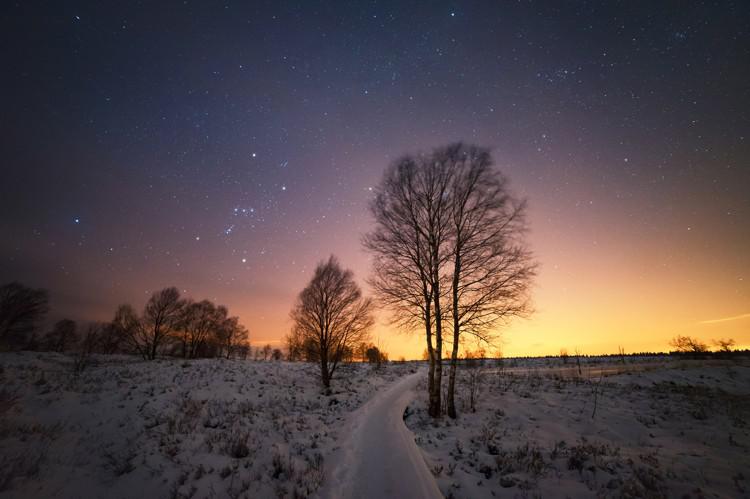This page describes an image Starry Night over Eifel national park, by Dong Han, China
Image caption:
First place in the 2021 IAU OAE Astrophotography Contest, category Light pollution.
Light pollution results from the excess of artificial light produced by human endeavours mainly as a side effect of industrialisation. This kind of pollution is usually most noticeable around well populated areas associated with intense human activities, such as street lighting, lights from the transportation system, buildings and houses. But it can also come from other places, such as ships and oil platforms in the sea. This image taken in a national park in Belgium in 2018 shows the detrimental effect of light pollution on the most precious resource that connects all humans together – the night sky.
Scroll to captions in other languages
Image credit:
Dong Han/IAU OAE
DOI: 10.5281/zenodo.5366218
Related glossary terms:
Light Pollution
Categories:
Naked Eye Astronomy
Image license: Creative Commons Attribution 4.0 International (CC BY 4.0) Creative Commons Attribution 4.0 International (CC BY 4.0) icons
The media file captions presented on the OAE website were written, translated and reviewed by a collective effort from the OAE, the OAE Centers and Nodes, the OAE National Astronomy Education Coordinators (NAECs) and other volunteers. You can find a full list of credits for our translation project here. All media file captions are released under a Creative Commons CC BY-4.0 license and should be credited to "IAU OAE". The media files themselves may have different licenses (see above) and should be credited as listed above under "credit".
If you notice a factual error in this caption or an error in any of its translations then please get in touch.
Captions in Different Languages:
Image caption: Premier prix du concours d'astrophotographie 2021 de l'UAI OAE, catégorie Pollution lumineuse.
La pollution lumineuse résulte de l'excès de lumière artificielle produite par les activités humaines, principalement en tant qu'effet secondaire de l'industrialisation. Ce type de pollution est généralement plus visible autour des zones bien peuplées associées à des activités humaines intenses, telles que l'éclairage des rues, les lumières du système de transport, les bâtiments et les maisons. Mais elle peut également provenir d'autres endroits, comme les navires et les plates-formes pétrolières en mer. Cette image prise dans un parc national en Belgique en 2018 montre l'effet néfaste de la pollution lumineuse sur la ressource la plus précieuse qui relie tous les humains entre eux : le ciel nocturne.
Image credit: Dong Han/IAU OAE
Related glossary terms: Pollution lumineuse Caption translation status: Not yet approved by a reviewer
Caption translators: François Dulieu
Image caption: Primo posto al concorso di astrofotografia IAU OAE 2021, categoria 'Inquinamento luminoso'.
L'inquinamento luminoso consiste nell'eccesso di luce artificiale prodotta dall'uomo, ed è uno dei principali effetti collaterali del processo di industrializzazione. Questo tipo di inquinamento è decisamente più marcato nelle aree ad elevata densità di popolazione, ed è riconducibile all'intensa attività umana. È una conseguenza, per esempio, dell'illuminazione pubblica, e delle luci dei mezzi di trasporto, degli uffici e delle abitazioni private. Ma le sue fonti sono innumerevoli, e comprendono perfino le navi e le piattaforme petrolifere in mare aperto. Questa immagine, scattata in un parco nazionale del Belgio nel 2018, mostra l'effetto deleterio dell'inquinamento luminoso sulla risorsa più preziosa che unisce tutti gli esseri umani: il cielo notturno.
Image credit: Dong Han/IAU OAE
Related glossary terms: Inquinamento luminoso Caption translation status: Approved by a reviewer
Caption translators: Giuliana Giobbi, Emanuele Nardini
Caption reviewers: Rosa Valiante, Rodolfo Canestrari
Image caption: 2021年国际天文学联合会教育办公室天文摄影大赛光污染类别一等奖作品
光污染是人类活动产生的过量人造光造成的,主要是工业化的副产品。这种污染通常在与人类活动程度高的人口稠密相关区域最为明显,例如街道照明、交通系统、建筑物和住宅的灯光。但它也可能来自其他地方,如海上的船只和石油平台。这张照片拍摄于2018年比利时的一座国家公园,展现了光污染对将所有人类连接在一起的最珍贵资源——夜空——所造成的破坏性影响。
Image credit: 韩东(音译)/国际天文学联合会教育办公室
Related glossary terms: 光污染 Caption translation status: Not yet approved by a reviewer
Caption translators: Li Jiankang
Image caption: 2021年國際天文學聯合會教育辦公室天文攝影大賽光汙染類別一等獎作品
光汙染是人類活動產生的過量人造光造成的,主要是工業化的副產品。這種汙染通常在與人類活動程度高的人口稠密相關區域最為明顯,例如街道照明、交通系統、建築物和住宅的燈光。但它也可能來自其他地方,如海上的船隻和石油平臺。這張照片拍攝於2018年比利時的一座國家公園,展現了光汙染對將所有人類連接在一起的最珍貴資源——夜空——所造成的破壞性影響。
Image credit: 韓東(音譯)/國際天文學聯合會教育辦公室
Related glossary terms: 光汙染 Caption translation status: Not yet approved by a reviewer
Caption translators: An automated transliteration from the simplified Chinese translation by - Li Jiankang









